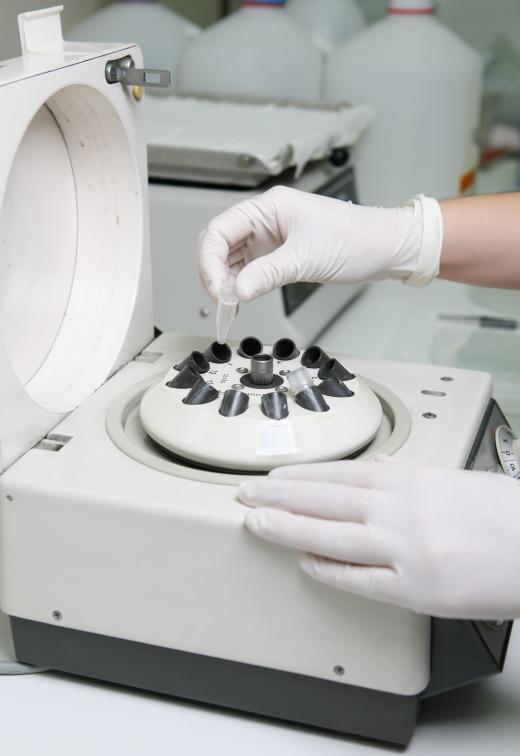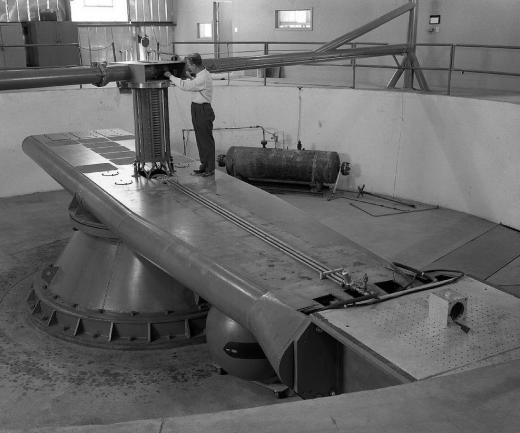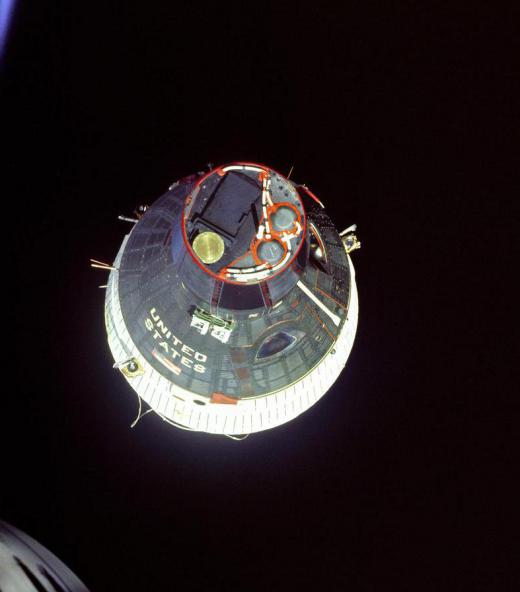What is a Centrifuge?
 Jeff Petersen
Jeff Petersen
Centrifuges are machines used in laboratories, medical facilities, and industries to separate suspended material from the mediums they are mixed with. This is done by spinning closed containers of the mixture very quickly around a fixed, central point. The centrifugal force generated by this motion forces the denser material in the suspension against the walls of the container, effectively separating it from the solution. These devices are used to separate solids from fluid suspension mediums; for example, they are an essential medical tool for separating plasma from blood samples.
How They Work

The core principle of centrifuge operation is centrifugal force. If a bucket half-filled with water is spun quickly in a circle, over the head and back down to the ground, centrifugal force created by the rotation of the bucket forces the water towards the bottom. This is what keeps the water in the bucket even when it's upside down.
Most centrifuges harness this force in a similar way, and consist of a casing with a lid and a driven central rotor. The rotor has a row of holes around its circumference into which the containers, typically test tubes, of solution are placed. Once the machine lid is closed and the centrifuge switched on, the rotor spins at high speed. As is the case with the bucket experiment, centrifugal force causes any matter in the solution denser than the liquid to be forced against the outer walls of the tubes, separating it from the fluid in the process.

Once the centrifuge has completed its cycle, it is gradually slowed and brought to a stop to prevent any turbulence that could cause the solution to re-mix. This slowing period also allows all the separated material to drop towards the bottom of the test tube. Once the rotor has stopped, the tube may be removed and the samples processed.
In some cases, a centrifuge may have a screen at one end, allowing liquids to pass through while solids remained trapped inside the tube. Others may hold the tubes at a fixed angle, or allow them to swing out as they spin. The position of the tube and the speed at which the centrifuge spins can vary, depending on the type of solution being separated.
Separation by Density

Any number of suspended materials can be separated from a suspension in this way. Each different substance will separate in order of its density, forming distinct layers at the bottom of the tube when the machine is stopped. This is known as the sedimentation principle. For example, a sample of blood put into a centrifuge for a suitable cycle length will completely break down with heavier blood cells collecting at the bottom and lighter blood plasma at the top. This is of particular use in identifying all the components of unknown solutions.
Other Uses

Centrifuge devices are not only used in laboratories; they see extensive use in wastewater management, in the oil industry, and even in the processing of sugar and milk. Typically, medical and scientific laboratory centrifuges are small desk-top devices. Industrial machines used to separate magnetite slurry from process water in a coal plant, on the other hand, can be very large.

Gas centrifuges used in the process of uranium enrichment feature specially designed containers that include a strategically placed inner scoop. When spun, this scoop collects the desirable uranium-235 isotope while the heavier 238 isotope collects on the walls of the container. This is, however, a far longer process than fluid suspension separation, often taking several thousand cycles to achieve.
Large centrifuges are also used to expose people to extreme forces in a controlled environment. The outward force created by such a large machine can be used to simulate the massive gravitational forces (G-forces) that an astronaut or fighter pilot is likely to experience when traveling at very high speeds. Geotechnical modeling is another area where centrifuges are used to simulate gravitational stresses in prototypes.
AS FEATURED ON:
AS FEATURED ON:















Discussion Comments
i think you'll find that if you apply Newtonian laws to a circular plane centrifugal force quite happily exists.
Washing machine also use centripetal force to squeeze water from the clothes being washed.
If friction was able to stop the books from continuing on their previous path, then the frictional force is the necessary centripetal force to keep the book going in a circular motion. Both the car and book move along a circle. By Newton's third law, friction was a reaction force to some other action force. Without going into detail about the action force, action force (centrifugal) is opposite to the direction of the reaction force (centripetal force). The action force is the centrifugal force and it does not act on the book and however it acts on the agent which produced the frictional force. Hence it is not correct to say that there is no such thing as "centrifugal" force. However, a book that goes flying off is not due to centrifugal force, rather it is due to inertia in the absence of frictional force. In that case, there is no centripetal force on the book and hence no centrifugal force which are action reaction pair.
There is no such thing as "centrifugal" force. It is a made-up force that is named after the centrifuge. The concept of a "centrifugal" force is a result of poor physical analysis of certain situations. Suppose you have books on your seat next to you in your car. You turn a corner sharply and the books go flying and hit the opposite side of the car. You might say that this is an example of "centrifugal" force, but what really happened was a result of Newton's First Law. When the car makes a quick turn, the books will continue to travel with their previous velocity until acted on by "an outside force." The friction between the books and the seat is the force that acts. Friction, however, was not able to stop the books from continuing on their previous path. Thus the books went flying against the car. I hope this post is helpful. Keep up the good work.
Post your comments